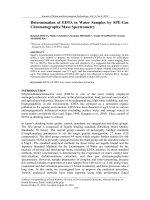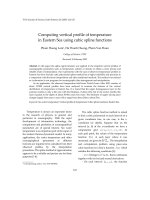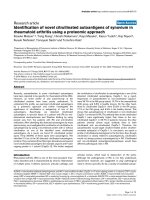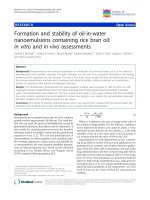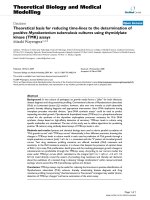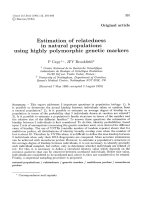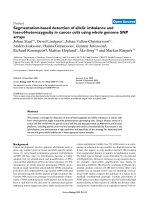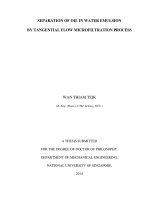Determination of ammonia in water samples using NDA fluorescence derivatization with different nucleophiles
Bạn đang xem bản rút gọn của tài liệu. Xem và tải ngay bản đầy đủ của tài liệu tại đây (1.63 MB, 59 trang )
THAI NGUYEN UNIVERSITY
UNIVERSITY OF AGRICULTURE AND FORESTRY
PHẠM THỊ HẢI VÂN
TOPIC TITLE: DETERMINATION OF AMMONIA IN WATER SAMPLES
USING NDA FLUORESCENCE DERIVATIZATION WITH DIFFERENT
NUCLEOPHILES
BACHELOR THESIS
Study Mode
: Full-time
Major
: Environmental Science and Management
Faculty
: International Training and Development Center
Batch
: 2011-2015
Thai Nguyen, 9/2015
i
Thai Nguyen University of Agriculture and Forestry
Degree Program :
Bachelor of Environmental Science and Management
Student name :
Phạm Thị Hải Vân
Student ID :
DTN 1153070072
Determination of Ammonia in Water Samples Using NDA
Thesis Title :
Fluorescence Derivatization with Different Nucleophiles
- Assoc.Prof. WU ,Chien-Hou
Supervisor (s):
- Assoc.Prof .Dr. Do Thi Lan
Abstract: Fluorescence has been in use by physical chemists for many years.
Based on emission capacity of substance that has absorbed light or other
electromagnetic
radiation,
fluorescence
seems as
one
method
with highest
applicability in chemical analysis. An attraction of fluorescence is its sensitivity,
which
helps scientists
save
time
in
research.
Based on
that
advantage, fluorescence has widely application for determining ammonia and other
possible nitrogen-containing photoproduct compounds (amine, amino acid...)
with derivatizing reagent,
OPA
(o-phthaldialdehyde).
On
the
other
hand,
naphthalene-2,3-Dicarboxaldehyde (NDA) has been estimated as another popular
derivatizing reagent, that can form much more stable derivatives with amines than
OPA derivatives(Carlson, 1986).
This study was to optimize the derivatization conditions including concentration
of NDA, maximum excitation and emission wavelengths, reaction pH, reaction
temperature and time, and choice of nucleophiles for analysis of ammonia in aqueous
solution.
Keywords:
Fluorescence, Naphthalene-2,3-dicarboxaldehyde (NDA),
Ammonia, Cyanide, Sulfite.
Number of Pages:
Date of Submission:
53
September, 30, 2015
ii
ACKNOWLEDGEMENT
To have completed this thesis, in addition to the ongoing efforts of myself, I would
like to thank for teachers in faculty of International Training and Development as well as
teachers in Thai Nguyen University of Agriculture and Forestry, who have dedicated
teaching to me the valuable knowledge during study time in university and gave me a
chance to do my thesis oversea. It is with immense gratitude that I acknowledge the
support and help of Biomedical Engineering & Environmental Science Department,
National Tsing Hua University for accepting me to working in this wonderful place.
Furthermore, express my sincere deepest gratitude to Assoc. Prof. Wu Chien Hou,
from Biomedical Engineering & Environmental Science Department, National Tsing Hua
University and Assoc.Prof. Dr. Do Thi Lan from Thai Nguyen University of Agriculture
and Forestry, who directly guided and created favorable conditions for me during the
implementation of this thesis.
Next, i would like spend special thanks to Mr. Bill (Wang Chin Yi) PhD student
and my friends in the laboratory facilitated and provided the information and data
necessary for my implementation process and helped me finish this thesis.
Finally, I would like to sincerely thank my family, all of my friends who always
beside me all the time, giving spiritual help for me complete the tasks assigned during
learning and research doing this thesis experiment.
In the process of implementing the project, my thesis might have inevitable
shortcomings. Therefore, would like to receive the attention and feedback from teachers
and friends to this thesis is more complete
Sincerely,
Pham Thi Hai Van
iii
TABLE OF CONTENT
LIST OF FIGURES ............................................................................................................. 1
LIST OF TABLE ................................................................................................................. 3
PART I. INTRODUCTION ................................................................................................ 5
1.1.Research rationale.......................................................................................................... 5
1.2.Objectives of the research ............................................................................................. 6
1.3.Research questions and hypothesis ............................................................................... 6
1.4.Limitations of research .................................................................................................. 6
PART II. LITERATURE REVIEW. ................................................................................... 7
2.1. Ammonia .................................................................................................................... 7
2.1.1 The properties of ammonia ......................................................................................... 7
2.1.2. Origins of ammonia pollution in water ..................................................................... 8
2.2.Methods for determinate ammonia ................................................................................ 9
2.2.1.Ion Chromatography ................................................................................................... 9
2.2.2.Voltammetry ............................................................................................................. 10
2.2.3Fluorescence .............................................................................................................. 11
2.3.Overview of research and application of NDA in fluorescence .................................. 12
2.3.1.o-phthaldialdehyde (OPA)........................................................................................ 12
2.3.2.Naphthalene-2,3-dicarboxaldehyde (NDA) ............................................................. 14
PART III. METHODS ....................................................................................................... 16
3.1. Material ....................................................................................................................... 16
3.1.1 Chemicals ................................................................................................................. 16
iv
3.1.2 Equipment ................................................................................................................. 16
3.2 Methods ....................................................................................................................... 18
3.2.1. Determine the optimum concentration .................................................................... 18
3.2.2. Fluorescence Spectrophotometer............................................................................. 21
3.3. HPLC system .............................................................................................................. 24
PART IV. RESULTS ........................................................................................................ 27
4.1. NDA-ammonia-sulfite reaction .................................................................................. 27
4.1.1 Optimization Excitation and Emission wavelength ................................................. 27
4.1.2. Effect of pH value on the fluorescence of NDA4.1.3. Effect of reaction time on the fluorescence of NDA-
-sulfite product .................... 28
-sulfite product ............. 29
4.1.4. Effect of reaction temperature on the fluorescence of NDA-
-sulfite product . 30
4.1.5. Effect of ratio between NDA and sulfite on the fluorescence of NDA-
-sulfite
product ............................................................................................................................... 31
4.1.6 Apply Pertinent Parameters on determine ammonia ................................................ 33
4.2. NDA-ammonia-cyanide reaction................................................................................ 34
4.2.1 Optimization Excitation and Emission wavelength ................................................. 34
4.2.2 Effect of reaction time on the fluorescence of NDA-
-Cyanide product ........... 35
4.2.3 Effect of reaction temperature on the fluorescence of NDA-
-Cyanide product36
4.2.4. Effect of ratio between NDA and cyanide on the fluorescence of NDA-
-sulfite
product ............................................................................................................................... 37
4.2.5 Apply Pertinent Parameters on determine ammonia ................................................ 38
4.3 Determine ammonia using HPLC-fluorescence system .............................................. 40
v
4.3.1 NDA-ammonia-sulfite reaction ................................................................................ 40
4.3.2 NDA-ammonia-cyanide reaction.............................................................................. 42
PART V. DISCUSSION AND CONCLUSION ............................................................... 45
5.1. Discussion ................................................................................................................... 45
5.2 Conclusion ................................................................................................................... 46
REFERENCES .................................................................................................................. 47
vi
LIST OF FIGURES
Figures
Page
Figure 2.1 Synthesis NDA
15
Figure3.1 Fluorescence Spectrophotometer System
17
Figure 3.2 HPLC Fluorescence System Diagram
18
Figure 3.3 Warm Up Sample Solution
20
Figure4.1 Excitation And Emission Of NDA-Ammonia-Sulfite Reaction
27
Figure 4. 2 Effect Of Reaction Ph On The Fluorescence Of NDA-NH 28
Sulfite Product
Figure 4. 3 Effect Of Reaction Time On The Fluorescence Of NDA-NH -
29
Sulfite Product
Figure 4. 4 Effect Of Reaction Temperature On The Fluorescence Of NDA-
30
NH -Sulfite Product
Figure 4. 5 Effect Of Ratio Between NDA And Sulfite At NDA=0.5mm
31
Figure 4. 6 Effect Of Ratio Between NDA And Sulfite At NDA=1mm
32
Figure 4. 7 Effect Of Ratio Between NDA And Sulfite At NDA=2mm
32
1
Figure 4. 8 Determine Ammonia By Fluorescence Using NDA-Sulfite
33
Figure 4. 9 Calibration Curve Of NH + From Standard Solution
34
Figure4.10 Excitation And Emission Of NDA-Ammonia-Cyanide Reaction
35
Figure 4.11 Effect Of Reaction Time On The Fluorescence Of NDA-NH 36
Cyanide Product
Figure 4.12 Effect Of Reaction Temperature On The Fluorescence Of NDA-
37
NH -Cyanide Product
Figure 4.13 Effect Of Ratio Between NDA And Cyanide On The
Fluorescence Of NDA-NH -Cyanide Product.
38
Figure 4.14 Determine Ammonia By Fluorescence Using NDA-Cyanide
39
Figure 4.15 Calibration Curve Of NH + From Standard Solution
40
Figure 4.16 Determine Ammonia By HPLC-Fluorescence Using NDA41
Sulfite With Solvent DIW And Methanol
Figure 4.17 Determine Ammonia By HPLC-Fluorescence Using NDASulfite With Solvent Acetate Buffer And Methanol
42
Figure 4.18 Determine Ammonia By HPLC-Fluorescence Using NDACyanide With Solvent Acetate Buffer And Methanol
Figure 4.19 Calibration Curve Of NH + From Standard Solution
2
43
44
LIST OF TABLE
Table
Page
Table 1.1 Physical and chemical properties of ammonia
Table 2.1 Physical and chemical properties of o-phthaldialdehyde
Table 3.1 dilute NH working solution
8
14
20
Table 3.2 HPLC-Fluorescence instrument setting condition
3
25
LIST OF ABBREVIATIONS
HPLC
High Performance Liquid Chromatography
IC
Ion chromatography
NDA
Naphthalene-2,3-dicarboxaldehyde
OPA
o-phthaldialdehyde
DIW
Deionized water
PPB
Parts Per Billion
4
PART I. INTRODUCTION
1.1.
Research rationale
Ammonium ion is an important micronutrient significantly contributing to the
nutritional needs for terrestrial organisms and intermediate of the nitrogen cycle in aquatic
ecosystem. Ammonia also plays an important role in fertilizer industry, providing fuel for
production of nitrogenous fertilizers about 83% of total consumption of ammonia.
However, Ammonium is a common alkaline pollutant in water; it directly impacts the
habitat of aquatic organisms in water. Increasing amount of ammonia in water leads to
ammonia excretion in organisms and level of ammonia in blood and tissue will increase.
Therefore, increase blood pH, has negative impact to enzyme catalyzed reaction and
fastness of cell membrane. Ammonia increases the oxygen demand in the tissue, injured
membrane and reduced oxygen transport capacity of blood. So control status of ammonia
discharged into the environment and the development of a sensitive and selective analytic
method for ammonium is one matter interested in protect aquatic ecosystem.
In recent years, different methods and techniques have been developed for the analysis
of ammonium ion, such as fluorescence, voltammetry, and ion chromatography.
Especially, the fluorescence method has been in use by physical chemists in general and
analytical chemistry in particular for many years by advantage of the intrinsically high
sensitivity and help scientist save time in study. Numerous useful reagents have also been
developed to take advantage of the intrinsically high sensitivity of fluorescence detection
such as dansyl chloride, fluorescamine, nitrobenzoxadiazoles , and o-phthaladehyde. OPhthaladehyde (OPA) has been the most widely used in this method because of its low
cost, rapid reaction and highly fluorescent adduct (absorption maxima at 230 and 340 nm
5
and emission maximum at 455 nm). Nevertheless, precolumn derivatization methods are
used the reported detection limits with OPA and conventional (nonlaser) fluorescence
detection are in the vicinity of 100 nmol. One such reagent which appears to have
excellent potential for primary amino acids and peptides is 2,3-naphthalenedialdehyde
(NDA), which when used in the presence of cyanide as the nucleophile, yields adducts of
excellent thermal stability and high quantum yields. Ammonia have similar configuration
with amino acid. Thus, this project conducted “Determination of Ammonia in Water
Samples Using NDA Fluorescence Derivatization with Different Nuclephiles” to find
which nucleophile have high performance in NDA1.2.
Reaction.
Objectives of the research
The aim of this work was to evaluate the analytical performance of NDA in determine
ammonia using fluorescence system and to find out which nucleophile are suitable with
that method.
The specific objectives of this study are:
−
To optimize of pertinent parameters of The NDA-
−
To evaluate applicability of NDA-
1.3.
Research questions and hypothesis
Reaction
Reaction in HPLC system
1.
Does fluorescence can determine ammonia by using NDA reagent?
2.
How to optimize of pertinent parameters of the NDA-
1.4.
reaction?
Limitations of research
Because the thesis training time was too short, this research project is incomplete.
6
PART II. LITERATURE REVIEW.
2.1. Ammonia
2.1.1 The properties of ammonia
Ammonia is a compound of nitrogen and hydrogen with the formula
. Ammonium
is present at the environment have origin from conversion process, agriculture, industry
and from sterilization of water by chloramine. The extent of its toxicity to aquatic life
depend upon the degree of ionization, which in turn depends upon the temperature, the pH,
and the concentration of dissolved salts in the water Natural amount of ammonium in
surface water and ground water are usually lower than 0.2 mg / liter (from 21,5 µg/l to
221,7 µg/l). Ammonia can enter environmental water as a product of anaerobic
decomposition of nitrogen-containing compounds or from waste streams containing
ammonia. The livestock large scale can increase ammonia amount in surface water.
Ammonium contamination may increase due to pipe connection by cement mortar. The
amount of ammonia in the environment compared with the synthesis inside body is
negligible. It’s just affect to body when dosage over 200 mg / kg body weight.
The toxicity of ammonia is critically dependent on pH and temperature. The un-ionized
form (
) is more toxic than the ionized form (
converted to (
). As pH increases,
is
) and the toxicity increases. Higher temperatures also favor the more
toxic form. (California Environmental Protection Agency, 2011)
Physical and chemical properties of ammonia:
7
Table 1.1 Physical and chemical properties of ammonia (Chisholm, 1911)
Property
Value
Melting point
−77.73 °C (−107.91 °F; 195.42 K)
Boiling point
−33.34 °C (−28.01 °F; 239.81 K)
Density of vapor
0.6 g/L at 20 °C
Water solubility
421 g/L at 20 °C
Vapor pressure
882 kPa at 20 °C
1.78 × 10
Equilibrium constant
(pKa = 8.75)
2.1.2. Origins of ammonia pollution in water
The ammonium ion is the dominant form of ammonium, while ammonia is a minor
component. Ammonia dissolve in water become ammonium hydroxide (
separate to ammonium ion (
OH) and then
) and hydroxide ions (OH-). There are many causes of
the contamination status of ammonium and organic substances in water but one of the
mainsprings is because using large amount organic fertilizer, pesticide, chemicals,
vegetable in agricultural activities, livestock. It has impact seriously to water resources.
The decomposition of organic compounds and that Substance can promote ammonia
contamination process in ground water.
Moreover, sewage from daily life and food industry also is Emission sources ammonia to
environment, concentration of ammonia in that water really high (approximate 100 mg/L).
8
2.2.
Methods for determinate ammonia
Nowadays several methods have been developed to determine ammonia. In this part,
first I will review some methods widely used in determine analytical chemistry in general
and determine ammonia in particular. Next, the advantages and disadvantages of these
methods will be compared with method we use in this study to see which methods are
more suitable
2.2.1. Ion Chromatography
Ion Chromatography is method use for water chemistry analysis. It’s used to separate
the individual cations and anions in solution and quantitatively determine their
concentrations. Ion chromatographs are able to measure concentrations of major anions,
such as fluoride, chloride, nitrate, nitrite, and sulfate, also major cations such as lithium,
sodium, ammonium, potassium, calcium, and magnesium in the parts-per-billion (ppb)
range.( Monica, 2006)
Moreover, ion chromatography is considered the method has many positive points such
as:
-
The time necessary to perform an analysis short, the average analysis time could be
reduced to about 10 minutes.
-
With high sensitivities in the pmol range, ion chromatography could detection in
the medium and lower ppb concentration range without pre-concentration.
-
It’s ability to simultaneously detect sample components. Anion and Cation profiles
may be obtained within a short time.
9
-
Specific compound classes such as heavy metals, alkaline-earth metals, polyvalent
anion, silicate, etc. can be detected with high selectivity, this high degree of selectivity
facilitates the identification of unknown sample components
Although, ion chromatography has some advantage on average analysis time, high
sensitivities, simultaneous detection, but it also has some limited such:
-
Today, the analysis of inorganic anion is most important with baseline-resolved
reparation requires only three minutes. Thus, quantitative results are obtained in a fraction
of the time previously necessary using traditional wet chemical methods, so increase
sample throughput
-
This technique has the detection limit for simple inorganic anion and cation is
about 10 ppb based on an injection volume of 50
. Therefore have detection limits with
some compound.
-
One disadvantage of that method with organic polymers is their limited stability
toward organic solvent, so cannot be used for removal of organic contaminants.(Weiss,
2004)
Base on the advantage and disadvantage we recommend that ion chromatography method
not really meet the demands of researchers in analytical chemistry service.
2.2.2. Voltammetry
Voltammetry is electro analytical methods used for analytical chemistry and
various industrial processes. In voltammetry, information about an analytic is obtained by
measuring the current as the potential is varied (Thomas, 2001). Voltammetry techniques
are based on the recording of the current, which flows between the working electrode and
an auxiliary electrode, due to the reduction or oxidation of the test element. An important
10
factor which influences the efficiency of a particular voltammetry analysis (limit of
detection, sensitivity and resolution of adjacent current signals) is the degree of
reversibility of the electrode process.
This method has large application in many analysis laboratories with series of applications
for determine chemical compound. However, in determine ammonia the detection limit of
electrode is quite ppb might need long time to balance, and we need large amount of
experiment do determine .( Anne, 1993)
2.2.3 Fluorescence
Fluorescence derivatization-HPLC is method have widely application in chemical
analysis. It allows the separation of chemical constituents through the use of a mobile
phase and a stationary phase.
Base on pumps to pass a pressurized liquid solvent containing the sample mixture
through a column filled with a solid adsorbent material. Each component in the sample
interacts slightly differently with the absorbent material, causing different flow rates for
the different components and separating out as they move at different speeds. The process
can be completed in roughly 10 to 30 minutes, and it delivers high resolution. Therefore, it
versatile and extremely precise when apply to identifying and quantifying chemical
components. (Clare, 2015) Beside that advantage HPLC also have disadvantage is can be
costly, requiring large quantities of expensive organics and it does have low sensitivity for
certain compounds, some cannot be detected as they are irreversibly adsorbed. In HPLC
have three major variables affecting fluorescence are solvents, temperature, pH (Kuo,
2005), so we need optimize that factor of sample before inject to HPLC system.
11
Nowadays, the application of HPLC to determine ammonia and organic matter
compound of nitrogen almost using reagent is, o-phthalaldehyde to produce a highly
fluorescent. Although this reagent have widely analytical application, but a number of
drawbacks make it less than an ideal method. For example, the isoindole produced in the
derivatization are relatively unstable and decompose to non-fluorescent products.
Furthermore, it has been reported that OPA fails to give fluorescent products with small
peptides, thus, limiting the applications to simple amino acids.( Carlson, 1986). To remove
that affect, today in some research, scientist was change OPA by NDA one compound
with structure 2-substituted Benz and 2 group CHO similar with OPA but it was
anticipated that it would have greater aqueous solubility and more stably.
2.3.
Overview of research and application of NDA in fluorescence
Nowadays, to develop quality of derivatization reaction, many reagents have been used
for derivatization of amines, amino acids and related compounds, for example,
fluorescamine, dansyl. Chloride, 4-fluoro-7-nitrobenzo-2-oxa-1, 3-diazole (NBD-F), ophthaldialdehyde (OPA), Naphthalene-2,3-dicarboxaldehyde (NDA). However, each
reagent has some limitation such as need long reaction time, unstably, or high cost… Thus,
in this part we present about properties of two reagents have widely using in fluorescent to
compare advantage and disadvantage of that reagent.
2.3.1. o-phthaldialdehyde (OPA)
The molecule is a dialdehyde, consisting of two formyl (CHO) groups attached to
adjacent carbon centres on a benzene ring. This pale yellow solid is a building block in the
synthesis of heterocyclic compounds and a reagent in the analysis of amino acids. OPA
12
dissolves in water solution at pH < 11.5. Its solutions degrade upon UV illumination and
exposure to air. The physical and chemical properties of OPA show in table 2.3.1
In reaction with amines OPA have outstanding advantages than other derivatization
reagents is quickly and exhibits greater fluorescence quantum yields, the derivatization
reaction plateaus at a maximum level after approximately 1 min.( Petr, 2004) and it’s also
have successful in determine ammonia using ion chromatography employing post-column
derivatization with sulfite, with A highly sensitive, reproducible and selective.( Kuo, 2005)
Although, OPA have some positive point in fluorescence and has become a standard
method for the very low-level analysis of ammonia, amines and amino acids. However, it
also has some drawbacks negative. For example, the isoindoles 2 produced in the
derivatization are relatively unstable and decompose to non-fluorescent products.
Furthermore, it has been reported that OP fails to give fluorescent products with small
peptides, thus limiting the applications to simple amino acids (Carlson, 1986). Moreover,
it is easy to determinate ammonia by ion chromatography(IC). But when we use IC to
determinate real samples contained higher concentration of NaCl, the
influence on
+ signal can
signal. It is the reason that why we developed OPA fluorescence
method to determinate ammonia since Na+ cannot derivated with OPA
13
Table 2.1 Physical and chemical properties of o-phthaldialdehyde (Bill, 1954)
Property
Value
Melting point
55.5 to 56 °C (131.9 to 132.8 °F; 328.6
to 329.1 K)
Boiling point
266.1 °C (511.0 °F; 539.2 K)
Density of vapor
1.19 g/mL
Water solubility
Low
Chemical formula
C8H6O2
Molar mass
134.13 g·mol−1
2.3.2. Naphthalene-2,3-dicarboxaldehyde (NDA)
Naphthalene-2,3-dicarboxaldehyde(NDA) is the chemical compound with the formula
C12H8O2, is shown to be a very useful reagent for the derivatization of primary amines,
amino acids, and small peptides. The reaction of these amino compounds with NDA and
cyanide ion produces highly fluorescent, and relatively stable. Moreover, based on some
research about determine amines and acid amine by fluorescence using reagent is NDA
with Nucleophile is CN recommend that NDA have fluorogenic properties as OPA and
adding certain new features such as greater solution stability and higher fluorescence
efficiency of the product isoindole, derivatization of small peptides, and greater efficiency
in the isoindole formation reactions.
14
However, NDA is no longer commercially available and is not readily available, it was
synthesized from 2,3-dimethylnaphthalene by the method of Ried.(the method to synthesis
NDA show in figure2.3.2), Therefore, costs of experiment could be affected
Figure 2.1 synthesis NDA: (i) NaI, DMF; (ii) NaOH, HzO, H30+; (iii) LiAlH,, EtzO;
(iv) oxalyl chloride, Me,SO, CH2C12.( Carlson, 1986)
Base on the advantage and disadvantage of NDA and OPA in derivatization reaction
to determine amines and amino acids, NDA are suitable to apply in analysis ammonium
using fluorescence. But as mentioned in part 2.2,3 that HPLC system can be effect by
temperature and reaction time and pH so optimization the concentration of method after
inject to HPLC system to analysis are necessary .
15
PART III. METHODS
3.1. Material
3.1.1 Chemicals
-
Deionized water (DIW)
-
Ammonium chloride (>99.5%)
-
Sodium sulfite (
-
Sodium cyanide (NaCN)
-
Borate Buffered/ Boric acid: (H BO )
-
Acetate Buffered/ Acetic acid (CH3COONa)
-
NDA Naphthalene-2,3-dicarboxaldehyde (
-
Methanol (
)
OH)
All solutions were made in distilled water
3.1.2 Equipment
-
Magnetic stirrer
-
Magnetic ball
-
Micropipette
-
Plastic tubes (Vial-1.5 mL and 2 mL)
-
Glasses tubes (Vial- 2 mL)
-
Foil paper
-
Thermometer
-
Injection needles
-
Scale
16
)
-
A vortex machine
-
Fluorescence Spectrophotometer (Cary Eclipse)
Figure3.1 Fluorescence Spectrophotometer system
High Performance Liquid Chromatography – HPLC system:
•
HPLC pump (LC – 20 AT, Shimadzu) this model use for gradient separation, it
allows including a low-pressure gradient unit. Flow rate range: 0.001 to 10.000 mL/min.
•
Detector: fluorescence detector (RD – 10 AXL, Shimadzu Co.)
•
Analytical column
•
Guard column
•
Sample injector: Phenomenex 7125 with 10
•
Degasser: On-line degasser for multiple solvents for HPLC (ERC-3215∝, ERC Inc.)
•
Data collection: Data collection and procession were performed by SISC signal
, (5
Hypersil ODS, Thermo Hypersil Co.),
, ODS (Security Guard Guard Cartridges Kits, Phenomenex Co,)
sample loop
collection interface card and related software. (Model 0224-2, chromatography data
station for HPLC, Scientific information service corporation)
17
Figure 3.2 HPLC fluorescence system diagram
3.2 Methods
3.2.1. Determine the optimum concentration
Preparation of stock solution
•
Prepare ammonia
Prepare
solution (10mM) Dissolved 0.013373 g of
in 25mL DIW. It’s
better when stored solution in refrigerate.
•
Prepare sulfite
Prepare
solution (20mM) dissolved 0.02521 g of
in 10mL DIW This
solution better when stored in refrigerate and using around 5day to 1 week, after that
should prepare new solution
•
Prepare NDA
Prepare Naphthalene-2,3-dicarboxaldehyde(
) solution (10mM) dissolved
0.01694g of NDA in 9.197 mL of MeOH stored this solution in glasses jar 10ml enclose
outside by Foil paper, then put this solution in refrigerate .
18
•
Prepare Cyanide
Prepared Cyanide(10mM) by dissolving 0.0245g of sodium cyanide (NaCN) in 50 mL of
DIW and adjusting the pH to the desired value with either perchloric acid (0.1 N) or
sodium hydroxide (0.1 N), in this solution
•
Prepare Borate buffer
This buffer prepare by dissolved 0.06183g H BO in about 80 mL DIW, then adjust pH to
9.00 with 7.0 N NaOH(aq), and graduate to 100mL (the reaction as shown in Eq. 3-1 and
the final concentration is 10mM). The solution is filtered with a 0.22 m PVDF filter to
remove the impurities. Stored this solution in refrigerate.
2 H BO + 2 H BO
•
+2
→
!
+5
(eq. 3-1)
Prepare Acetate buffer (0.025M, pH 5.7)
Prepare this solution by dissolved 0.92044 g of NaOAc in c.a. 450mL DIW; 69
CH
of 99%
is added and graduated to 500 mL. The final pH value of solution is 5.7. The
solution is stored in refrigerate and filtered through a 0.45 m membrane to remove the
impurities before using.
Experimental procedures
-
All sample were covered by foil paper in order to prevent the light entering inside
solutions
-
All working solution stored in ice after bring out refrigerate
-
Total volume of solution is 2mL for Fluorescence Spectrophotometer and 1mL for
HPLC system
19

